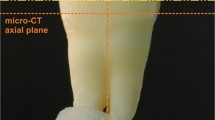Abstract
The aim of this paper was to quantitatively assess caries changes of teeth by using digital image analysis. Digital images of stained sections of crowns of teeth were acquired with a computer-assisted light microscope. In each image, spots representing the main and total demineralization of enamel were segmented to determine their area. The area of total demineralization was significantly different between premolars with sealed fissures and unprotected premolars as indicated by the Mann–Whitney test. Fissures on occlusal surfaces of premolars were characterized by their width, height, and distance from the bottom of the fissure to the enamel–dentin junction. This distance was also significantly different between protected and unprotected teeth. The results of our in vitro studies of enamel lesions allow us to plan an effective diagnosis, prophylaxis, and treatment of early caries changes in in vivo conditions. © 2003 Biomedical Engineering Society.
PAC2003: 8764Rr, 8757Ra, 8757Nk, 8780Pa
Similar content being viewed by others
References
Bjorndal, L., and A. Thylstrup. A structural analysis of approximal enamel caries lesions and subjacent dentin reactions. Eur. J. Oral Sci.103:25–31, 1995.
Carter, K., G. Landini, and A. D. Walmsley. Automated quantification of plaque accumulation using digital image analysis. J. Dent. Res.80:694, 1995.
Estrand, K. R., D. N. J. Ricketts, and E. A. M. Kidd. Reproducibility and accuracy of three methods for assessment of demineralization depth on the occlusal surface: An examination. Caries Res.31:224–231, 1997.
Feldens, E. G., C. A. Feldens, F. B. De Araujo, and M. L. Souza. Invasive technique of pit and fissure sealant in primary molars: A SEM study. J. Clin. Pediatr. Dent.18:187–190, 1997.
Futatsuki, M., K. Kubota, Y. C. Yeh, K. Park, and S. J. Moss. Early loss of pit and fissure sealant: A clinical and SEM study. J. Clin. Pediatr. Dent.19:99–104, 1995.
Garcia-Godoy, F., and F. B. De Araujo. Enhancement of fissure sealant penetration and adaptation—The enameloplasty technique. J. Clin. Pediatr. Dent.19:13–18, 1994.
Gwinnett, A. J.Structure and composition of enamel. Oper. Dent. Suppl.5:10–17, 1992.
Hirano, Y., and T. Aoba. Computer-assisted reconstruction of enamel fissures and carious lesions of human premolars. J. Dent. Res.74:1200–1205, 1995.
Hirayama, A.Experimental analytical electron microscopic studies on the quantitative analysis of elemental concentrations in biological thin specimens and its application to dental science. Shikwa Gakuho90:1019–1036, 1990.
Huysmans, M. C., C. Longbottom, H. Hintze, and E. H. Verdonschot. Surface-specific electrical occlusal caries diagnosis: Reproducibility, correlation with histological lesion depth, and tooth type tependence. Caries Res.32:330–336, 1998.
Ie, Y. L., E. H. Verdonschot, M. J. M. Schaeken, and M. A. van't Hof. Electrical conductance of fissure enamel in recently erupted molar teeth as related to caries status. Caries Res.29:94–95, 1995.
Lygidakis, N. A., K. I. Oulis, and I. A. Christodoulidis. Evaluation of fissure sealants retention following four different isolation and surface preparation techniques: Four-year clinical trials. J. Clin. Pediatr. Dent.19:23–25, 1994.
Matthews-Brzozowska, T., B. Miskowiak, K. Mehr, and E. Kaczmarek. Comparative histometric studies on enamel and dentine of premolar and molar teeth. J. Dent. Res.80:1284, 2001.
Palamara, J., P. P. Phakey, W. A. Rachinger, and H. J. Orams. Ultrastructure of spindles and tufts in human dental enamel. Adv. Dent. Res.2:249–257, 1989.
Ragazzoni, E., M. Martignoni, and D. Cocchia. The morphological and histochemical characteristics of the interprismatic structures and the human enamel. A light microscopy study. Minerva Stomatol.43:493–499, 1995.
Rosenstiel, S. F., and R. G. Rashid. Visual assessment of occlusal caries: A web-based dentists' survey. J. Dent. Educ.80:229, 2000.
Rosenstiel, S. F.Clinical diagnosis of dental caries: A North American perspective. In: Proceedings: NIH Consensus Development Conference on Diagnosis and Management of Dental Caries Throughout Life. J. Dent. Educ.65:979–984, 2001.
Salama, F. S., and N. S. Al-Hammad. Marginal seal of sealant and compomer materials with and without enameloplasty. International J. Paediatr. Dent.12:39–46, 2002.
Shapira, J., and E. Edelman. Six-year clinical evaluation of fissure sealants placed after mechanical preparation: A matched pair study. Pediatr. Dent.8:204–205, 1986.
Simonsen, R. J.The clinical effectivness of colored pit and fissure sealant at 36 months. J. Am. Dent. Assoc.102:323–327, 1981.
Stopa, J., T. Matthews-Brzozowska, B. Miśkowiak, A. Surdacka, M. Chmielnik, K. Jozwiak, G. Mesmacque, E. Kaczmarek, and A. Cellary. Determination of qualitative and quantitative carietic lesions in the enamel using various measuring techniques. In: BMI' 98. Biomedical Measurement and Instrumentation. Proceedings of the 8th International IMEKO Conference on Measurement in Clinical Medicine. Dubrovnik, Croatia, 16–19 September 1998. Zagreb, 1998, pp. 5–46–5–49.
Takamori, K., N. Hokari, Y. Okumura, and S. Watanabe. Detection of occlusal caries under sealants by use of a laser fluorescence system. J. Clin. Laser Med. Surg.19:267–271, 2001.
Tam, L. E., and D. McComb. Diagnosis of occlusal caries: Part II. Recent diagnostic technologies. Can. Dent. Assoc.67:459–463, 2001.
Watson, T. F., W. M. Petroll, H. D Cavanagh, and J. V. Jester. confocal microscopy in dental research: An initial appraisal. J. Dent.20:352–358, 1992.
Whittaker, D. K.The enamel–dentine junction of human and Macaca irus teeth a light and electron microscopic study. J. Anat.125:323–335, 1978.
Author information
Authors and Affiliations
Rights and permissions
About this article
Cite this article
Kaczmarek, E., Matthews-Brzozowska, T. & Miskowiak, B. Digital Image Analysis in Dental Research Applied for Treatment of Fissures on Occlusal Surfaces of Premolars. Annals of Biomedical Engineering 31, 931–936 (2003). https://doi.org/10.1114/1.1588653
Issue Date:
DOI: https://doi.org/10.1114/1.1588653




